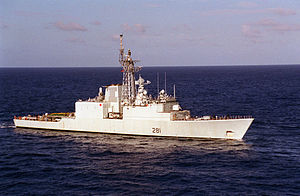 HMCS Huron (DDG 281) in 1999
| |
| History | |
|---|---|
| Name | Huron |
| Namesake | Huron |
| Builder | Marine Industries, Sorel |
| Laid down | 1 June 1969 |
| Launched | 9 April 1971 |
| Commissioned | 16 December 1972 |
| Refit | 25 November 1994 (TRUMP) |
| Identification | Pennant number: 281 |
| Motto | Ready the brave[2] |
| Honours and awards | Atlantic 1943,
Arctic 1943–1945, Biscay 1943–1944, Norway 1945, Korea 1952–1953[1] |
| Fate | Sunk 14 May 2007 during Operation Trident Fury, a live-fire exercise conducted by MARPAC 100 km (54.0 nmi) west of Vancouver Island. |
| Notes | Colours: Gold and crimson[2] |
| Badge | Or a nicotine bloom gules, seedpod vert and stamens or.[2] |
| General characteristics | |
| Class and type | Iroquois-class destroyer |
| Displacement | 5100 t |
| Length | 129.8 m (425.9 ft) |
| Beam | 15.2 m (49.9 ft) |
| Draught | 4.7 m (15.4 ft) |
| Propulsion |
|
| Speed | 29 kn (53.7 km/h) |
| Range | 4,500 nmi (8,334.0 km) |
| Complement | 280 |
| Sensors and processing systems |
|
| Armament |
|
| Aircraft carried | 2 × CH-124 Sea King helicopters |
| Aviation facilities | hangar and flight deck |
HMCS Huron was an Iroquois-class destroyer that served with the Canadian Forces from 16 December 1972 to 23 October 2000. She served mainly on the western coast of Canada. After decommissioning, her hull was stripped to be used in a live-fire exercise. The ship's hulk was eventually sunk by gunfire from her sister ship, HMCS Algonquin. Huron was the second ship of her class and the second vessel to use the designation HMCS Huron.
- ^ "Volume 2, Part 1: Extant Commissioned Ships". Department of National Defence – Directorate of History and Heritage. 2007. Archived from the original on 4 March 2012. Retrieved 3 June 2014.
- ^ a b c Arbuckle, p. 48